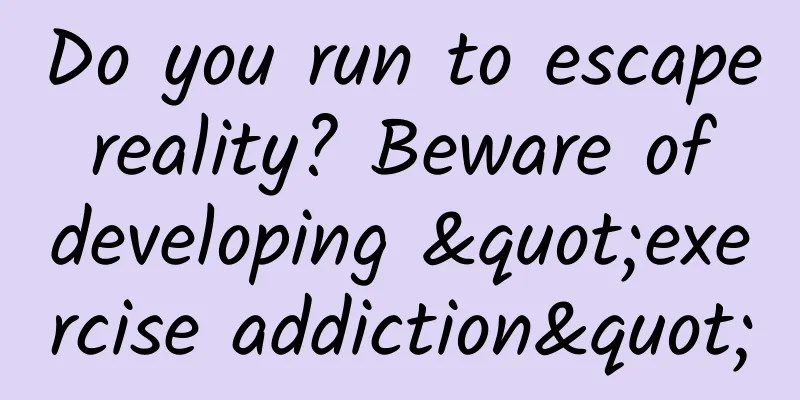Do you run to escape reality? Beware of developing "exercise addiction"

|
Written by: Nan An The New Year has passed, and the spring of 2023 is approaching in a flash. More and more people are heading to the sports field and the gym. Some people want to get rid of the extra fat accumulated last year; while others hope to rely on exercise to temporarily escape the pressure of real life . Looking at all sports, running has a very high level of public awareness and participation. According to the 2022 Mass Fitness Behavior and Consumption Research Report released by the China Sporting Goods Industry Association, running is one of the top five sports with the highest public participation (the others are brisk walking, badminton, swimming, and table tennis). Moreover, since running does not require the use of any equipment, has no venue or time restrictions, and has a low technical requirement threshold, it has become the first choice for most people's exercise. However, a survey study involving 227 people showed that running frequently to escape the pressure of reality may not be worth the cost. Specifically, if a person chooses to escape negative emotions and avoid real-life pressures through running, he or she may become addicted to running, and then develop a dependence on exercise, which can lead to mental health problems. In severe cases, the person may not be able to properly arrange his or her time because of his or her insistence on running, which affects his or her normal life. Data shows that about a quarter of recreational runners and 40% of competitive runners show signs of exercise addiction. The related research paper, titled “Running to get “lost”? Two types of escapism in recreational running and their relations to exercise dependence and subjective well-being”, has been published in the scientific journal Frontiers in Psychology. Escapism: An everyday human phenomenon Escapism is often defined as “an activity, form of entertainment, etc. that helps you avoid or forget about unpleasant or boring things.” In other words, many of our daily activities might be understood as escapism. Just as shopping sprees, binge-watching movies or music festivals, and fanatical support for your favorite football, hockey, or basketball player can all provide a brief escape from reality, running can also be an activity that takes your mind off yourself. Essentially, escapism is “the habitual diversion of the mind into purely imaginative pursuits or recreations designed to escape reality or ordinary life” (Merriam-Webster Dictionary), or “activities, forms of recreation, etc., that help to avoid or forget unpleasant or boring matters” (Oxford University Press, 2011). The first author of this study, Dr. Frode Stenseng of the Norwegian University of Science and Technology, and others proposed a two-dimensional model of escapism in 2012 and developed a corresponding escapism scale. In this model, they divided escapism into two dimensions: self-inhibition and self-expansion . Among them, maladaptive escapism aims to avoid negative experiences, that is, self-inhibition, while adaptive escapism seeks positive experiences, that is, self-expansion. Self-suppression motivation is rooted in prevention motivation, where the main goal of engaging in escapist activities is to distract oneself from uncomfortable psychological processes. The main characteristic of self-suppression is to cognitively avoid problems temporarily through procrastination and suppression. For example, some people choose to run to prevent or suppress troublesome thoughts or emotions. Procrastination has a similar motivation, namely "putting off until tomorrow what should be done today", where individuals avoid urgent tasks due to lack of a proactive mindset, while at the same time, the tasks become more urgent and the situation more disturbing. Self-expansion motivation is rooted in promotion motivation, and individuals may experience more positive effects from activity participation, but they also gain more long-term benefits from participation. This type of motivation is related to passion, that is, people will be more interested in activities that nourish their subjective well-being. Compared with self-inhibition, self-expansion is related to the experience of flow in activities, which usually means acknowledging challenges and then actively seeking solutions to solve them. Overall, escapist activities used for self-expansion have more positive effects and longer-term benefits. In contrast, self-suppression tends to suppress both positive and negative emotions and leads to avoidant behaviors. Stenseng notes in the paper that “these two forms of escape stem from two different mindsets, one promoting positive emotions and the other preventing negative emotions,” and that “ escapism is an everyday human phenomenon, yet little is known about its motivational basis, how it affects experience, and the resulting psychological consequences .” Is it exercise dependence? Or subjective well-being? What effect does "escapist" running have on people? What psychological problems can running to escape daily stress bring? Recreational running has many benefits for physical and mental health, but running to escape negative emotions can lead to runners becoming dependent on it, and just like in gaming, some people develop a morbid interest in running . In this research, in order to clarify the relationship between psychological dependence and happiness in running and the dark and bright sides of escapism, Stenseng et al. recruited 227 recreational runners to fill out questionnaires for a cross-sectional study. Through correlation analysis and path modeling, they examined the differential relationships between two dimensions of escapism, namely self-inhibition and self-expansion, and exercise addiction and subjective well-being. The results showed that, surprisingly, signs of exercise dependence were common even among recreational runners . Both self-expansion avoidance (r=0.34, p<0.01) and self-inhibition avoidance (r=0.53, p<0.01) were positively correlated with exercise dependence, but self-inhibition was more strongly associated with exercise dependence. Of course, "escapist" running can also make individuals feel happy to a certain extent . Self-expansion is positively correlated with subjective well-being (r=0.17, p<0.05), while self-restraint is negatively correlated with it (r=-0.38, p<0.01). Notably, the two patterns of escapism were not related to a person’s age, gender, or how long they had been running, but both influenced the relationship between health and exercise dependence. Regardless of whether a person met the criteria for exercise dependence, a preference for self-expansion was still associated with more positive feelings about their health. Self-inhibition was more strongly associated with exercise dependence and general subjective illness than was self-expansion . Although exercise dependence erodes potential health gains from exercise, it appears that lower perceived well-being may be both a cause and a consequence of exercise dependence: such dependence may be driven by lower well-being or may promote it. “More longitudinal research is needed to uncover more about the motivational dynamics and consequences of escapism,” Stenseng et al. note in their paper. “However, these findings may provide insights into understanding one’s own motivations and be used to treat individuals who struggle with maladaptive activities.” In order to avoid exercise addiction and dependence, perhaps we should adjust from both psychological and physiological aspects. For example, develop a reasonable fitness plan and refuse to over-exercise; at the same time, increase the diversity of exercise, alternate between different types of exercise, etc. Of course, it is particularly important to run with a positive attitude . References: https://www.frontiersin.org/articles/10.3389/fpsyg.2022.1035196/full https://blog.frontiersin.org/2023/01/25/using-running-to-escape-everyday-stresses-may-lead-to-exercise-dependence-instead-of-mental-wellbeing/ http://m.ce.cn/bwzg/201810/30/t20181030_30660179.shtml https://www.sciencedirect.com/science/article/abs/pii/S0065260108603810 https://www.sport.gov.cn/n20001280/n20067608/n20067635/c24935211/content.html https://www.tandfonline.com/doi/abs/10.1080/01490400.2012.633849 https://www.sciencedirect.com/science/article/abs/pii/0092656688900153 https://doi.org/10.1016/S0065-2601(08)60381-0 https://doi.org/10.1016/0092-6566(88)90015-3 |
<<: Want to go diving in Sanya? Don’t touch these “punishing” corals
>>: Remember the "Ozone Hole"? It healed quietly!
Recommend
Don’t buy crafts made from this kind of snail! Otherwise, they will also go extinct…
If you go to the market on weekends, you will def...
How to monetize TikTok?
Recently, Tik Tok has become a battleground for M...
Lanzhou shared power bank mini program has customized functions. How much does the shared power bank mini program cost?
With the advent of the 5G era, the network speed o...
Tea drinking resources in the three towns of Wuhan
Wuhan high-end tea drinking is unique and very un...
WeChat rewards everyone with a top-of-the-line iPhone. Zhang Xiaolong: The year-end bonus is so high that it might scare everyone.
Although the overall situation in 2018 is not goo...
The gamma photon scientific data of the "Wukong" dark matter particle detection satellite is officially released
On September 7, 2021, the National Space Science ...
Never left: Spartan has built-in IE opening function
A new version of Windows 10 (Windows 10 build 100...
What is the advertising process on iQiyi?
If you have free time, you must watch TV series! ...
More than a month after the new App Store went online, are all the chart-manipulating companies doomed?
September 20th was a big day for the gaming indus...
Two simple steps to ensure you pick a good watermelon with thin, crispy and sweet skin! Everyone can learn
How can you not eat melon in summer? But for most...
Google brings Android Live Captions to Chrome
Live Caption is a feature released with the launc...
The Double 11 battle is coming, don't worry, I'm not asking you to spend money
[51CTO.com original article] It is November at th...
Samsung Galaxy S5 first test
Let's start with the appearance. The design of...
How to use a public account with 200 followers to create an H5 that has 100,000+ views?
At the beginning of 2018, we made an H5, which wa...
The mass extinction of 3-meter-tall prehistoric giant apes is actually related to their "picky eating"?
The mystery of the extinction of Gigantopithecus,...









